Irish Terrier Ear Training
The vast majority of Irish Terrier puppies must have their ears trained in order to attain proper ear carriage. The ear is carried in many positions when the dog is at ease. Ear training is designed to affix the position of the ear when the dog is alert and carrying his ears up.
It is difficult to recommend a single method for training ears because of the variety of ear sizes, the varying amount of cartilage which different ears contain, and the unique location upon the skull each pair of ears maintains. Because of these varying factors and differences in human perception, no two Irish Terrier breeders train ears in identical fashion. Several tips and suggestions from a variety of breeders are compiled herein to serve as a guide to the training of ears. As different as each breeder's methods are, each of them are linked by one common theme: persistence.
Between six and twelve weeks of age most Irish Terrier puppies begin to pull their ears up into position. The first sign is a small ridge beginning to rise a short distance away form where the ear is joined to the top of the head, Some ears immediately pop up and into position. Others lift partially and a few do not lift at all. Regardless of the pup's ear carriage as a result of lifting the ears at the early age of six to twelve weeks, the carriage will probably be altered as the puppy begins to cut adult teeth. The teething process onsets at four and one-half months and continues until nearly eight months of age.
The majority of breeders begin setting ears during the six to twelve week period and continue setting them through the bulk of the teething period. The ears are trained primarily by gluing them to the skull. The preferred glues are duo-surgical adhesives, fabric menders, and special canine ear-setting glues. In most instances the glue is applied to the underside of the ear and the ear is pressed onto the skull or folded against itself.
The overall goal of training ears is to create a good carriage. This may be broken down into two sub-goals: helping the ear lift, and helping the ear fold tightly so that the tip will touch the head. During the teething process, the calcium needed to set the lift and fold in the ear cartilage is shunted away to teeth and bones. The lack of consistent amounts of calcium during this critical period of development causes the ears to stand or drop improperly.
|
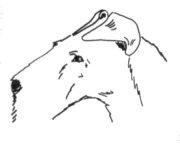 To assist the lift at the point where the top of the ear joins the skull many breeders set the ear high on the skull towards the middle of the head. Sometimes this technique flattens the bell of the ear, causing the outer portion of the ear to stand out or, in several cases, to curl back over itself into a rosed-ear.
In Diagram 1: Ears set high on the skull create lift.
|
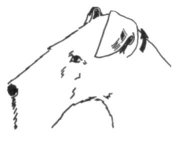 To correct this tendency and create a tight fold which brings the tip of the ear down against the head the ear is often reset with the tip glued very close to the base of the ear. These methods are often used alternately.
In Diagram 2: The tips glued close to the base creates a crease across the ear and gives proper convex curvature to the bell.
|
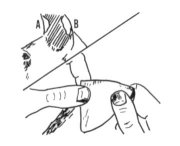 Some breeders prefer to apply glue to he inside of the top fold and the inside of the bell. These areas are then pressed together to create a sharp fold at the top of th ear and give proper shape to the bell. Glue is then applied to the exterior of the top fold and to the inner top edge of the ear. The fold is glued to the back of the skull and the top edge to the skull behind the brow.
In Diagram 3: Place glue on inside top fold (A) and inside bell (B), then press together.
|
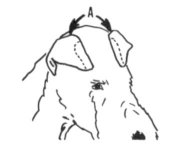 When gluing and setting the ear always leave some open space to allow air to ventilate the ear canal. If strips of tape are used to secure the ear while the glue dries then remove the tape immediately after the glue is dry. A coating of the ear and skull area with Tincture of Benzoine or Tincture of Benzoine with Aloe (available via your pharmacist) is often used prior to applying the glue. This will help to prevent sores and reactions to the gluing. It will also help the glue to adhere.
In Diagram 4: Glue the exterior of the top fold to the back of the head (A), and the top edge of the ear to the skull behind the brow.
|
|
During the ear setting process, smell your dog's ears on a daily basis. If there is an unusual smell or 'off' odor, take the ears down immediately, using oil or Spray and Wash as described below. Clean out the inner ears. Let them air out for at least twenty-four hours, making sure that they are not infected before setting them again.
Most good ear sets will stay in position for seven to ten days. When the ears come unfastened clean them, allow them to air out for twenty-four hours and then reset them. Do not pull or rip the ear lose from the skull or pull or rip the glue off of the ear. Any oil, such as baby oil, olive oil, cold cream, or cooking oil, will soften the glue to help with removal. A flea comb can be used to further assist the removal of the glue once it is softened. Alternatives to glue removal with oil are: Spray and Wash (soak the glue for five to ten minutes then comb out) or Albolene Liquifying Cleanser (available at your drugstore).
Keep setting the ears until you are certain they no longer show signs of rising off the skull or slumping down the cheek. Ear training lasts for a relatively short period of time in the dog's life, three to six months out of a lifetime of twelve to fifteen or more years. If necessary the ears can be set until several months after the dog has attained his full growth. For bitches, the onset of the first season will often require that the ears be set again. Setting the ears in the correct locations and doing so consistently are the keys to successful ear training.
|
GLUE
• Duo-Surgical glue is hard to find. It is white creamy glue and is non-irritating. After setting the ear by glueing, you can temporarily wrap tape to hold the ears in place until the glue becomes dry. In larger cities you can find this glue at a medical supply store.
• Jiffy Sew Dog-Eared Cement* is a fabric cement marketed by Jiffy Products Inc., Peterborough, ON Canada. Jiffy Products Inc.
R.R. 4
Peterborough, ON K9J 6X5 Canada
Phone: (705) 742-9901
Fax: (705) 742-4088
http://www.jiffysew.com/
• Leech Dog Ear Cement was one of the best available. It is no longer manufactured; but, if there is enough demand, perhaps Leech will begin making it again. Once before Leech stopped making Dog Ear Cement and brought it back due to demand. Leech Products, Inc.
1430 W 4th Ave.
Hutchinson, KS 67501-5035 USA
Phone: (316) 669-0145 or (800) 992-9018
Fax: (316) 669-1183
• Texticroche (SADER)* is a quick setting latex glue used for textiles. Manufactured in France by CECA SA. It may be purchased from most big hardware stores in France. If the ear must be unglued (for cleaning or so), there is a solvent called Remove, manufactured by Smith and Nephew.
• Val-A Tear Mender* is a fabric-leather cement that contains natural latex. Tear Mender is manufactured by Val-A Chicago of Chicago, IL USA.
* = Recommended Glues
Remember that glues have a shelf life. It is best to buy the glue from a source where the glue is as fresh as possible. Kennel & Pet Supply houses may carry some of these glues, but it may not be as fresh as it needs to be for proper use. Also, unless you plan to share your purchase, only purchase what you think you will need.
EQUIPMENT
The following equipment is recommended for use in setting ears:
- Grooming Table with adjustable arm and grooming noose.
- Glue.
- Narrow masking tape
- Q-Tips and rubbing alcohol (to clean the inner ear).
- Tincture of Benzoine and cotton balls.
The most important of piece of equipment, besides the glue, is the grooming table. The grooming table will allow you to use both hands, and the dog will be sufficiently restrained until the glue is dry. Never leave your Irish Terrier unattended on the grooming table... not even to just answer the phone.
EAR SETTING by Linda Honey, Rockledge Irish Terriers
|
An Irish Terrier puppy, on the grooming table, ready to have his ears set.
|
 |
- Clean the inner ear with Q-tips soaked in rubbing alcohol. The rubbing alcohol will dry quickly and will help with removal of dirt and wax in the ear.
- Using cotton balls, apply Tincture of Benzoine to the inner ear flap and the top of the head. Allow the Tincture of Benzoine to dry.
- Place glue on the inside of the ear. It is easier to just fold the ear inside out. Wait a few minutes until the glue becomes tacky.
|
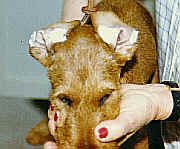 |
- Fold ear right side out with tip of ear pointing to the outside edge of the eye. Hold both edges firmly until they are secure.
|
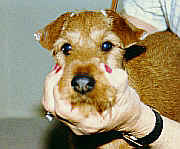 |
- Put more glue on the inside edge of the ear between the inside fold and the head and down the inside ear flap (not the tip). Again, wait until tacky then press firmly against the head until it is secure.
|
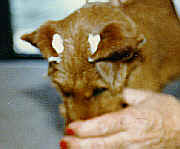
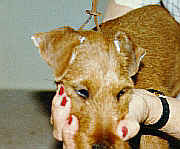 |
- Adhesive tape or masking tape is a good idea until the glue is thoroughly dry. Start the tape under the chin, come behind one ear and across the other, go back around reversing the process. Leave the tape on overnight, then remove.
|
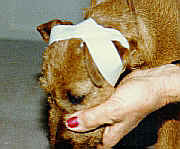
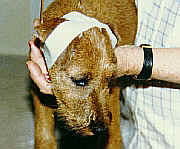 |
The real secret to obtaining a good earset is to be fanatical!!! Whenever the ears are free of sores or raw spots and are not glued, they should be. Once the ears start holding, they should be left alone until they start falling again... then they should be immediately glued again. Don't get discouraged... it's been known to take six months, but it works. Usually, it only takes a few months; and it is well worth the effort. You will have a dog of whom you can be really proud, and you had something to do with it!!!
|
|